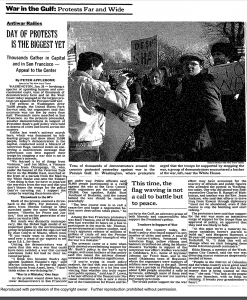
This newspaper article covers a march that occurred in January of 1991 in protest of American participation in the Gulf War. The article, and those interviewed, drew parallels to Vietnam’s peace movement, and noted that few government officials contributed to any of the marches nationwide. It highlights that unlike Vietnam, pro-troop sentiment was central to the march. Many Americans felt they could breathe a sigh of relief in 1991 as the Cold War came to a close. President George H.W. Bush was dedicated to building on Reagan’s reparation of the international image of America. America’s Gulf War began after Iraq’s Saddam Hussein invaded Kuwait over an oil dispute. While many validated American involvement, others were plagued with the “Vietnam Syndrome” – aversion to American involvement in overseas conflicts. The latter group emphasized lacking transparency from the government, which had been a concern since Vietnam. The protest that ensued after American forces began Operation Desert Storm showed a return to themes tapped in previous wars, and ignored during the Vietnam era – the marches demonstrated concern for preserving the lives of the troops whose lives were committed to the war[1]. Like the Women’s Peace March of 1917, the march drew on the mortality of humans to remind Americans that war is death. And, unlike the marches during the Vietnam era, a pro-troop sentiment was at the forefront of many peace marches during the Gulf War. Marches like these, however, did not reach the government, and the Gulf War ultimately laid the foundation for Bush’s son’s war in Iraq.
[1] Mirra, Carl. 2011. “The Mutation of the Vietnam Syndrome: Underreported Resistance during the 1991 Persian Gulf War.” Peace & Change36 (2): 262–84. doi:10.1111/j.1468-0130.2010.00691.x.
